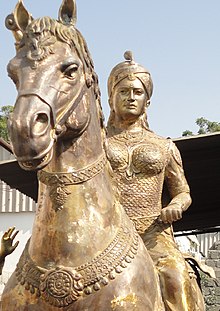| Rudrama-devi | |||||
|---|---|---|---|---|---|
| Raya-gaja-kesari | |||||
 A 21st century statue of Rudrama | |||||
| Reign | 1262 – November 1289[1] | ||||
| Predecessor | Ganapati-deva | ||||
| Successor | Prataparudra | ||||
| Died | November 1289 CE Possibly at Chandupatla (present-day Telangana, India) | ||||
| Spouse | Virabhadra | ||||
| |||||
| Dynasty | Kakatiya | ||||
| Father | Ganapati-deva | ||||
Rudrama Devi (r. c. 1262 - 1289), also known by her regnal name Rudra-deva Maharaja, was a Kakatiya queen who ruled substantial parts of present-day Telangana and Andhra Pradesh in southern India. She was among the few successful female rulers in Indian history.
Rudrama's father and predecessor Ganapati, who had no son, appointed her as his co-regent around 1260. By 1263, Rudrama became the sole ruler, although she was not formally anointed as a sovereign at least until 1269. Early during her reign, Rudrama appears to have faced a revolt, which she was able to suppress with the support of her loyalists. She recovered some of the territories that the Kakatiyas had lost during the late 1250s and the early 1260s to their southern neighbours - the Pandyas. She also repulsed invasions by the Seunas (Yadavas) from the north-west, and the Gajapatis from the north-east. In the 1270s and the 1280s, Rudrama lost much of her southern territory to a revolt by the Kayastha chief Amba-deva, and likely lost her life in a conflict against him in 1289. Her grandson Prataparudra succeeded her on the Kakatiya throne.
The reign of Rudrama was remarkable for the rise of several non-aristocratic warriors in the Kakatiya service. She strengthened the Warangal Fort by raising its inner wall and constructing an outer wall surrounded by a moat.
- ^ Smith, Bonnie G. (2008). The Oxford Encyclopedia of Women in World History. Vol. 1. Oxford University Press. p. 612. ISBN 978-0-19-514890-9.